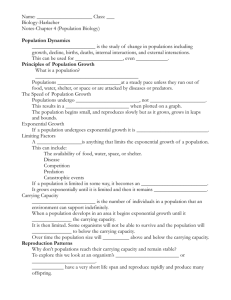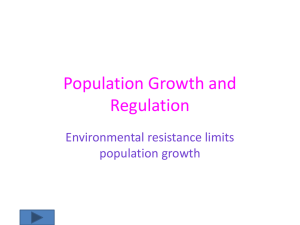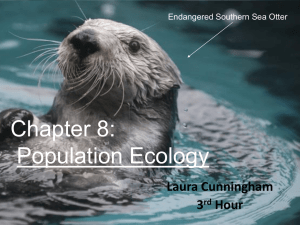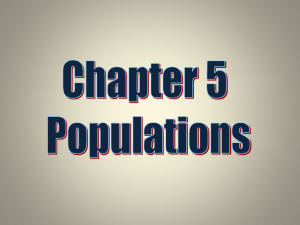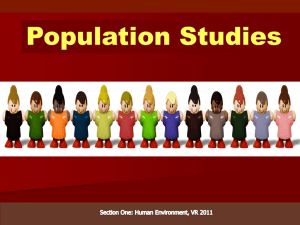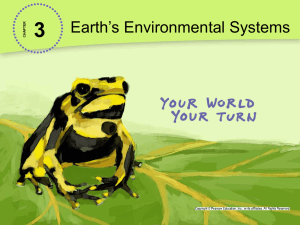Population Growth
advertisement
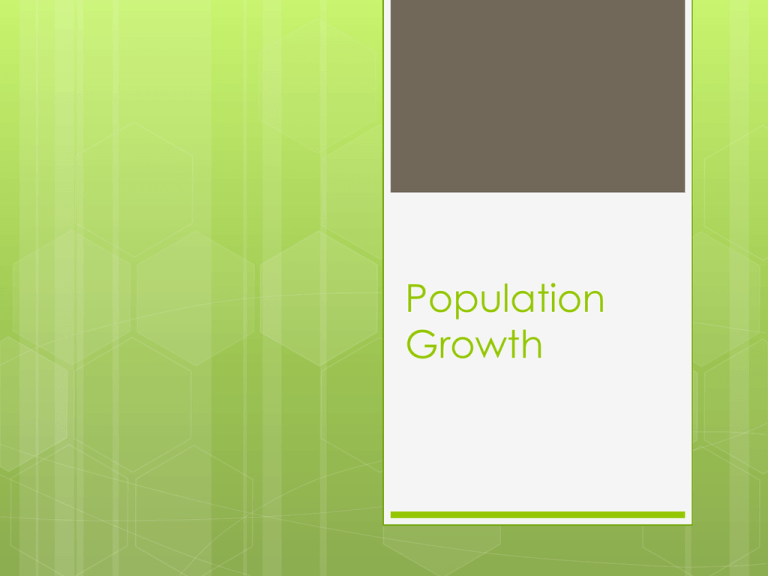
Population Growth Factors Affecting Population Growth Populations grow and shrink in response to abiotic and biotic factors. Abiotic – physical & chemical factors such as water & light availability, soil structure, salinity, pH, etc. Biotic – factors having to do with living organisms, like competition & predation. Population Growth Models We can study the way populations grow by using models. What happens when resources are unlimited? What limits population growth? Example – Waterhemp Waterhemp populations can grow quickly. When it occurs in soybean fields, it can reduce the crop of soybeans available to harvest. Geometric Growth When there are plenty of resources, the population can grow very rapidly. As the population grows, there are more individuals available to reproduce, so it grows faster. Geometric Growth If the estimated growth rate is 2.0, each individual will produce 2 offspring each year. 2,4,8,16,32,64 etc Geometric Growth A simple measure of population growth is the ratio of the population size at one time (Nt+1) to the population size in the previous time step (Nt). This is known as the finite rate of increase, denoted by lambda (λ). Geometric Growth The geometric population growth model: Nt = N0λt Population that reproduce all at once sometimes follow this growth model. Sockeye salmon Exponential Growth Some organisms can reproduce multiple times throughout the year. We need to adjust our growth equation. r=lnλ Exponential Growth dN/dt = rN N= population size t = time r = intrinsic rate of increase So, change in population size over time is the population size times r. Populations grow increasing fast due to increase in reproductive individuals. Positive feedback Exponential Growth When conditions are optimal, with unlimited resources, the population can grow at its maximum rate. rmax Exponential Growth The human population is growing exponentially. Logistic Growth In reality, populations usually can not sustain exponential growth for long. Resources become limiting. Logistic Growth Carrying Capacity (K) – the number of individuals the environment can support. The population grows exponentially, then levels off as K is reached and resources start to run low. Logistic Growth Example: sheep in Tasmania (southern Australia) Introduced in 1810 Reached carrying capacity around 1860 Fluctuates around carrying capacity Logistic Growth Equation Adds a carrying capacity component to the exponential growth equation: dN/dt = rN (1-N/K) Factors that Affect Population Growth Density dependent factors will affect population growth more when there are more individuals in a given area. Disease / parasites Food Light Space Predation Factors that Affect Population Growth Density independent factors affect population size in the same way regardless of population density. Storms Falling trees Natural disasters Example - Aphids Aphid populations will increase until they reach the carrying capacity. This is determined by limited resources – soybean leaves for example. When the population nears the carrying capacity, some individuals will get enough food to survive & reproduce, some get enough to just survive, and some will starve. Aphids Is food limitation an example of a densitydependent factor or a densityindependent factor? Density-dependent Density-independent Dispersal and Metapopulations Growth Rate Growth rate = births – deaths We must also account for immigration and emigration. Growth rate = births – deaths + immigration – emigration r = b-d + i-e Immigration If a habitat patch is small, it may not be able to permanently support a population. Immigrants from other patches can come in and rescue the population periodically. Source-Sink Populations Immigrants usually come from a neighboring population. If there is a large population surrounded by smaller populations, the small ones may be constantly re-populated by immigrants from the large one. Source-Sink Populations Population size and distance between ponds affects the probability of California tiger salamanders colonizing one pond from another in a system of ponds in Monterey County, CA. Trenham and colleagues estimated how far rescue effects from source ponds extend to other ponds that might be sinks, based on dispersal patterns and pond characteristics. Dispersal estimates are shown by arrows. Ponds with many emigrants, such as LC, are sources, while ponds that primarily have immigrants but not emigrants, such as CRP, are sinks. Dispersal Dispersal is important to help small populations avoid extinction. Allows organisms to escape competition, find mates, find new resources, etc. Take advantage of new space opened up after a landslide etc. Metapopulations A metapopulation is a set of subpopulations connected via dispersal. A metapopulation inhabits a shifting set of occupied and empty patches that together sustain the metapopulation for much longer than any one patch sustains a subpopulation. Variability in Populations Environmental stochasticity - refers to seemingly random variability in resource availability, ecological community composition, predation pressure, weather events, etc., which often causes fluctuations in a population's growth rate. Variability in Populations Demographic Stochasticity - Population growth rate is determined by birth and death rates. By chance, there could be many births in a row, leading to a higher population growth than you would expect. Or by chance, there could be a number of deaths in a row, leading to unexpected extinction. Variability in Populations The Allee effect occurs when populations reproduce at a slower rate than expected at low population densities. Meerkats form social groups where only one pair reproduces. Variability in Populations All of these sources of variability can make modeling and predicting population dynamics challenging.


